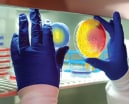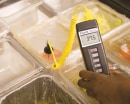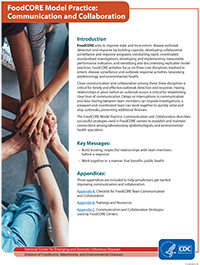Communication and Collaboration
FoodCORE aims to improve state and local enteric disease outbreak detection and response by building capacity; developing collaborative surveillance and response programs; conducting rapid, coordinated, standardized investigations; developing and implementing measurable performance indicators; and identifying and documenting replicable model practices. FoodCORE activities focus on three core disciplines involved in enteric disease surveillance and outbreak response activities: laboratory, epidemiology, and environmental health.
Close communication and collaboration among these three disciplines is critical for timely and effective outbreak detection and response. Having relationships in place before an outbreak occurs is critical for establishing clear lines of communication. Delays or interruptions in communication and data sharing between team members can impede investigations; a prepared and coordinated team can work together to quickly solve and stop outbreaks, preventing additional illnesses.
The FoodCORE Model Practice: Communication and Collaboration describes successful strategies used in FoodCORE centers to establish and maintain connections among laboratorians, epidemiologists, and environmental health specialists.
Key Messages:
- Build trusting, respectful relationships with team members before a response
- Work together in a manner that benefits public health
Identifying Team Members
In the FoodCORE centers, the size and members of each multidisciplinary team depends on the infrastructure and needs of the jurisdiction. The disciplines and agencies represented vary, but every team should have the knowledge, skills, and authority necessary for thorough surveillance and outbreak response activities. The essential members of successful teams are laboratorians, epidemiologists, and environmental health specialists that work for their state or local government. These positions can have different titles based on the jurisdiction and the scope of their responsibilities (e.g., public health nurse, sanitarian). Other disciplines may be included on a team depending on the needs of the investigation or jurisdiction; these may include public information officers, emergency preparedness experts, veterinarians, health care providers, and representatives from academia, private industry, and other jurisdictions such as the federal government.
The common members of teams – laboratorians, epidemiologists, and environmental health specialists – have specialized roles and depend on one another for the most effective response activities.
Listed below are common responsibilities of these team members in FoodCORE centers; however, some jurisdictions may combine roles, and the tasks may change given the needs of a particular situation.

- Test food, clinical, and environmental specimens and confirm test results from clinical labs
- Conduct molecular typing (PFGE and/or WGS) on isolates to identify clusters
- Report cases and clusters to epidemiology partners
- Advise environmental health specialists and epidemiologists on the collection, handling, and transport of specimens and follow-up testing
- Coordinate courier service and receive specimens from clinical labs
- Perform additional testing as needed (e.g., antimicrobial susceptibility testing)
- Provide updates on laboratory activities to epidemiologists and environmental health specialists

- Interview cases to gather exposure data to identify potential sources of infection
- Identify clusters and outbreaks from laboratory results and epidemiologic data
- Coordinate outbreak responses
- Distribute and collect stool specimen collection kits
- Conduct epidemiologic studies and analyses to determine the likely source of outbreaks
- Provide education to the public and exclude cases from high-risk settings to limit additional spread of infection (duty may be shared with or done by environmental health specialists)
- Provide updates on epidemiologic activities to laboratorians and environmental health specialists

- Conduct environmental health assessment at restaurants and growing, processing, manufacturing, and retail facilities
- Implement control measures in establishments where deficiencies are found
- Collect environmental, food, and food worker specimens
- Determine contributing factors and environmental antecedents (underlying factors) of outbreaks
- Collect data to conduct product traceback investigations
- Provide updates on environmental health activities to laboratorians and epidemiology partners
Improving Communication
Establishing Points of Contact
To improve communication and collaboration in their multidisciplinary teams, FoodCORE centers have started by engaging stakeholders and gathering contact information for core team members before an outbreak begins. At a minimum, this contact information includes primary phone numbers, 24-hour phone numbers, email addresses, and fax numbers. Other parties may need to be included in communication during particular situations (e.g., agency directors, people at other government agencies, health care providers, and public information officers), so including contact information for these additional roles has been useful to FoodCORE centers. With frequent staff turnover in some agencies, contact lists should be reviewed and updated throughout the year at least semi-annually.
After contact information is compiled, FoodCORE centers benefited from holding a meeting with at least the core members of the multidisciplinary team to introduce themselves, establish team member roles, and prepare communication protocols. A meeting is also a good opportunity to discuss the needs and challenges of the team and to develop a plan to address them. This is also an opportunity to learn the capabilities of the team members and their organizations (e.g., staffing levels, software licenses or expertise, upcoming changes or new activities, etc.). Having this information allows the team to maximize resources when facing time or resource constraints often encountered during outbreaks.
Examples of communication methods used by FoodCORE centers to keep partners informed include:
- The laboratory sends an email or calls the epidemiologists if an unusual pattern in their testing results is seen
- Epidemiologists send an email or call environmental health partners when they learn product or location information
- Conference calls or face-to-face meetings are held with all disciplines on a routine basis (i.e. daily, weekly, monthly)
Maintaining Open Communication
To be successful, communication must be maintained after initially bringing the team together. FoodCORE centers have established regular, bidirectional communication among team members. Bidirectional communication is essential for an effective multidisciplinary team; it ensures that all parties are informed throughout an investigation as well as during routine activities. This not only improves specific responses but also allows for the exchange of ideas about accomplishments, challenges, new projects, or other updates.
FoodCORE centers have planned weekly, biweekly, monthly, or quarterly multidisciplinary team meetings, depending on their specific needs, in addition to the ad hoc communication related to ongoing outbreak investigations. These meetings can be held in-person, by phone, or a combination, depending on the location of team members. When team members work in different locations making in-person meetings difficult, FoodCORE centers hold more frequent conference calls. A typical agenda includes discussion of current investigations, recently closed investigations, and ongoing projects and challenges. Weekly calls in FoodCORE centers are often quick updates that take less than 30 minutes. Using these methods helps the FoodCORE centers ensure rapid cluster detection, rapid interviewing, and rapid public health action.
Data Exchange
Examples of data exchange methods used by FoodCORE centers to keep partners informed include:
- Electronic databases that report data in real-time are accessible by multiple disciplines
- Spreadsheets are saved to a location where laboratorians can upload isolate testing results on a routine basis (i.e. daily, weekly), epidemiologists can analyze for clusters of illnesses, and environmental health partners can report traceback findings
- CIFOR Lab-Epi software or other IT solutions (see Training and Resources for more information) are used to facilitate exchange and review of laboratory data to identify outbreaks and clusters
To complement bidirectional communication efforts, FoodCORE centers have improved their data exchange practices. By granting core team members access to data, the team becomes more cohesive and critical data is available in a timely manner. The following practices have been successful in FoodCORE centers to improve data exchange:
- Epidemiologists have access to BioNumerics or state laboratory information management systems (LIMS)
- Laboratorians and environmental health specialists have access to epidemiologic surveillance databases with case information
- Team members have access to secured share drives/networks for storing and exchanging information
- Team members use platforms such as SharePoint and SEDRIC (System for Enteric Disease Response, Investigation, and Coordination) to access data for multistate outbreaks
- Students and staff members split their time between two or more disciplines to support data exchange (either by completing the tasks of multiple disciplines or by spending time working in multiple offices throughout the week)
Engaging Other Stakeholders
Enteric investigations often cross jurisdictions, so open communication is needed not only within a team, but across city, county, regional, and state borders. By implementing control measures locally, a team may be able to contribute to investigations and interventions on a state or national scale. To improve communications with local health departments, some FoodCORE centers conduct “roadshows”. During these events, FoodCORE staff travel around their state to show how the work of local health departments can impact investigations on a bigger scale by showcasing notable outbreaks. Roadshows are also a time to practice communicating during an outbreak tabletop exercise, discuss challenges, and make improvements. While visiting local health departments, FoodCORE centers also deliver trainings and advertise available resources such as updated protocols, interview teams, available laboratory resources, etc. If travel isn’t an option, roadshows can be conducted virtually through webinars.
Cross-Training
Cross-training, training in the roles and responsibilities of other team members, is one way to promote teamwork and collaboration on a multidisciplinary team. Cross-training strengthens teams by improving the understanding of each other’s tasks and allowing members to assist each other in ways that may be outside of their traditional roles. Team-based approaches to cross-training have the added benefit of strengthening and reinforcing relationships and communication between team members by bringing everyone together.
FoodCORE centers have conducted trainings in their jurisdictions using a variety of platforms. In some centers, multidisciplinary trainings have been part of planned outbreak exercises, less formal workgroups, and during in-person meetings of public health partners. Some centers use materials they have developed internally for those trainings, but there are also many training resources that are available to help jurisdictions improve collaboration across disciplines. These trainings vary in detail and breadth and some are available online while others are only offered in-person. The training and resources page has information on some specific training that FoodCORE centers have used.
Evaluating to Improve Collaboration
As centers have improved their team collaboration, they’ve used FoodCORE performance metrics to document their successes and identify areas for continued improvement. Many FoodCORE centers identified ways to improve communication and collaboration on their multidisciplinary teams by evaluating the timeliness and completeness of their processes through these metrics. Conducting process evaluations can start conversations and get all disciplines engaged in improvement strategies. There are resources available for jurisdictions wanting to perform an evaluation; they can use the FoodCORE performance metrics or less formal evaluation methods.
Implementing Change
An optional checklist Cdc-pdf
Communication and Collaboration Strategies Used by FoodCORE Centers
- Electronic laboratory data are imported daily into the state electronic disease reporting system.
- Laboratory staff email epidemiologists of clusters as soon as they are identified.
- Data are primarily shared via email but also in shared drives as needed for clusters and outbreaks.
- Data are stored in a variety of databases and/or online systems; access to different systems is determined based on role and need.
- Epidemiology and laboratory staff meet weekly via Google Hangouts to discuss current clusters, outbreaks, and other projects.
- pidemiology, laboratory, and environmental staff have quarterly meetings to discuss outbreaks, current projects, and successes/challenges.
- Epidemiology (including FoodCORE students), laboratory, and environmental staff all have access to CT Electronic Disease Surveillance System (CTEDSS), which contains illness, laboratory, and exposure data for reportable enteric disease cases.
- Laboratorians enters all molecular typing results directly into CTEDSS and notify epidemiologists of clusters on a daily basis.
- Epidemiology, laboratory, and environmental health all utilize CTEDSS as a management and communication tool during active outbreak investigations (e.g., share case line lists, share results of food worker/food/environmental testing).
- Epidemiology, laboratory, and environmental health have scheduled monthly conference calls; ad hoc phone and email communication occurs as needed in between scheduled calls.
- Laboratorians promptly email new molecular typing matches to all foodborne epidemiologists.
- All laboratory results (including molecular typing matches) are emailed to the foodborne epidemiologists at the end of each day using an automated report allowing the epidemiologists to double check for clusters.
- Cluster data are tracked in excel spreadsheets on a shared network drive.
- Every morning there is a short meeting that includes epidemiology and laboratory staff to discuss new infectious disease outbreaks and situations.
- Each Monday there is a longer, more in-depth meeting between zoonotic epidemiologists, foodborne epidemiologists, an environmental health liaison, and laboratory staff to discuss each cluster and outbreak investigation.
- State Epidemiology, Environmental Health, Public Health Laboratory, and Department of Agriculture Rapid Response Team staff are all co-located allowing for both formal and informal in-person meetings and discussions (e.g., during a new outbreak investigation, epidemiology staff will speak in-person with state environmental health staff and/or members of the Department of Agriculture’s Rapid Response Team in addition to email communication).
- Laboratory staff notify epidemiologists of shiga toxin-producing Escherichia coli (STEC) and Listeria clusters in real time and generate a weekly cluster report for Salmonella.
- Data are shared on a network drive and staff are in constant communication via email and phone.
- Laboratory, epidemiology, and environmental staff use various data systems to house their bureau-specific surveillance/investigation data such as Maven, StarLIMS, and NYCETRACK (which holds consumer complaint data); some staff have access to databases that are used by other groups.
- All staff have access to SEDRIC and a cluster/outbreak access database housed on a shared network drive.
- Laboratory, epidemiology, and environmental staff attend quarterly in-person meetings.
- Laboratory, epidemiology, and environmental staff attend biweekly cluster phone meetings.
- Laboratorians email outbreak epidemiologists about isolate matches as soon as molecular testing yields results.
- Data are available on a network drive that is accessible by laboratory and epidemiology staff.
- Laboratorians enter molecular typing data into a spreadsheet; epidemiologists enter these data into the outbreak module of the electronic Ohio Disease Reporting System as needed.
- In-person meetings are held 1-2 times per year; the meeting includes Ohio Department of Health staff (outbreak epidemiologists, FoodCORE interviewers, environmental health sanitarians, and laboratory scientists) and Ohio Department of Agriculture participants from the consumer protection, food safety, and veterinary diagnostic laboratories.
- Ohio has a weekly State Partners’ Call to discuss updates of public health importance; the meeting includes Ohio Department of Health staff (outbreak epidemiologists, FoodCORE interviewers, EIS officer, environmental health sanitarians, laboratory scientists, and CSTE Fellow) and Ohio Department of Agriculture participants from the consumer protection, food safety, and veterinary diagnostic laboratories.
- Laboratory staff email epidemiologists when molecular typing results are ready, usually once or twice a week; efforts are in place to automate this process so that results automatically populate into reportable diseases database and notify epidemiologists.
- Oregon public health epidemiologists’ user system (Orpheus) is an integrated electronic disease surveillance system for local and state epidemiologists and investigators to efficiently manage disease reports.
- Quarterly video conference meeting is attended by epidemiologists and laboratory managers.
- Quarterly in-person meeting is attended by foodborne disease epidemiologists and laboratory personnel.
- Public Health Division works closely with the Department of Agriculture during outbreak investigations; an interagency agreement is in place that describes the responsibilities of both agencies in investigations of foodborne illnesses and broader cooperative efforts between the two agencies.
- Laboratory staff email epidemiologists with clusters of interest and if a South Carolina case matches a national cluster/outbreak investigation.
- Epidemiologists have read-only access to a cluster spreadsheet that is maintained by the lab.
- Epidemiologists run a SAS program against the cluster spreadsheet to find and investigate additional clusters.
- Epidemiologists call the laboratorians as questions and issues arise (e.g., when two patterns are expected to match but don not, epidemiologists will call to ask how close they were).
- Epidemiologists share exposure data with laboratory staff when requested.
- FoodCORE epidemiologists have access to the online food complaint system allowing them to easily check if an establishment has complaints.
- Quarterly meetings are held with epidemiologists and laboratory staff; these are not specific to laboratory cluster testing results or clusters.
- Environmental staff are included on the distribution list for outbreak situation reports, attend monthly epidemiology meetings, and are invited to annual epidemiology conference.
- An epidemiologist (epi-lab liaison) serves as the liaison to the state public health laboratory and serves as the point person for addressing concerns between epidemiology and the laboratory.
- The epi-lab liaison analyzes BioNumerics, creates a weekly cluster report, and identifies and assigns new clusters for further investigation.
- The epi-lab liaison visits the laboratory every Wednesday; a representative from the laboratory team attends the foodborne epidemiology staff meeting about once per month.
- Large data files are shared with the laboratory via shared network drives; smaller data sharing occurs through an encrypted email system.
- The epi-lab liaison is identifying creative strategies for sharing sequencing data between laboratory and epidemiology staff (i.e., cloud-based, flash drives).
- Laboratory staff have access to outbreak data on a REDCap-based database that stores enteric outbreak information; this allows laboratory staff to retrieve information needed for outbreak specimen testing and CaliciNet reporting; the outbreak database has also been shared with epidemiologists and public health nurses in the field to share critical outbreak information in real time.
- Epidemiology, laboratory, and environmental health staff all have access Utah’s Electronic Disease Surveillance System (Trisano), which contains illness, laboratory, and exposure data for reportable enteric disease cases.
- Laboratory staff email epidemiologists about isolates linked to clusters as soon as they are identified.
- UDOH enteric disease epidemiologists and UPHL laboratorians have a bi-weekly meeting to check-in about on-going investigations, discuss any concerns or challenges, and generally touch base.
- Laboratorians and epidemiologists from across the state meet quarterly (CUEL meeting).
- Enteric epidemiologists and laboratorians have a conference call on Monday mornings to touch base, check-in about on-going investigations, and discuss any concerns or challenges.
- Enteric disease epidemiologists and food safety/waterborne environmental health staff meet on a quarterly basis to discuss recent investigations and work on protocol development and process improvement; these meetings are primarily in-person.
- Laboratorians email enteric disease epidemiologist in real-time when molecular typing is completed and analyzed and notify them if any isolates match other local isolates or national clusters.
- Epidemiologist have Bionumerics software so a molecular typing data is shared in real-time by the laboratory via a secure file share so it can be maintained in a local database.
- Epidemiologists run weekly surveillance reports of Salmonella and STEC cases that are shared with the laboratory via secure file share; report is reviewed to identify any reported cases without specimens forwarded to the laboratory and to identify cases with outstanding confirmation or molecular typing.
- Environmental staff have access to SEDRIC and receive OutbreakNet listserv and CDC cluster emails.
- Environmental-Epidemiology workgroup developed the Wisconsin NEARS Outbreak Onsite Assessment Guidelines (WNOOAG) for environmental health staff involved in foodborne outbreaks to have on hand a consistent methodology for conducting a NEARS assessment.
- A data-sharing tool was developed to coordinate NORS/NEARS reporting so data elements align and are reported consistently.
- Epidemiologist send initial outbreak notification (ION) reports for all suspected enteric disease outbreaks in the state. This is sent when an investigation is initiated and notifies relevant investigation partners of the investigation and provides a brief overview of what is known related to setting, number ill, testing requested and next steps. The ION typically is sent to the following partners:
- Local health department(s) that are or may be involved
- State epidemiology staff and supervisors
- State laboratory staff – this ensures any specimens submitted have the correct testing ordered
- State environmental staff are notified any time food or water may be a vehicle or if the location of exposure is a licensed facility (restaurant, pool, camps, caterer, etc.)
